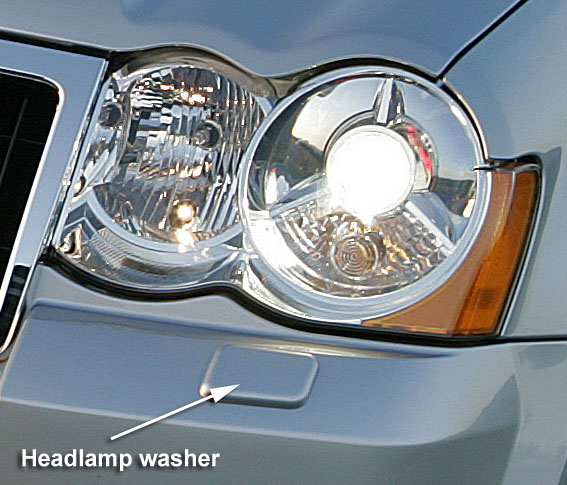Welcome to the JeepSpecs.com in-depth page on the WK Generation Jeep Grand Cherokee headlamp washer system. Did we miss anything? Please get in touch with us and tell us about it!
Vehicles equipped with the optional headlamp washer system have two hydraulically actuated telescopic headlamp washer nozzles, one beneath each front lamp unit. When not in use, these nozzle units are retracted below the front fascia below each front lamp unit where they are concealed by a trapezoid-like molded plastic cover that snaps onto the upper end of the nozzle.
The headlamp washer system is designed to provide the vehicle operator with a convenient, safe, and reliable means of maintaining High Intensity Discharge (HID) headlamp lighting performance. The various components of this system are designed to convert electrical energy produced by the vehicle electrical system into the hydraulic action of the washer system to apply washer fluid stored in an on-board reservoir to the lenses of the two front lamp units, removing excess accumulations of snow, ice, bugs, mud, or other minor debris from the front lamps that might be encountered while driving the vehicle under numerous types of inclement operating conditions.
The vehicle operator initiates the headlamp washer system function using the control knob on the end of the right multi-function switch control stalk that extends from the right side of the steering column, just below the steering wheel. While the HID headlamps are turned ON, pushing the knob on the end of the control stalk towards the steering column beyond the actuation point for more than about 100 milliseconds (0.10 second) activates the headlamp washer pump/motor in combination with the front washer pump/motor. When the headlamp washer pump/motor unit is energized, hydraulic pressure builds within the headlamp washer system plumbing against the pressure of the return spring in each headlamp washer nozzle. Sufficient pressure causes the headlamp washer nozzles to telescope outward and to dispense high pressure washer fluid onto the lenses of both front lamp units for about 1600 milliseconds (1.6 seconds).
Headlamp washer system operation is completely controlled by the Front Control Module (FCM) logic circuits based upon electronic wash command message inputs received from the ElectroMechanical Instrument Cluster (EMIC) (also known as the Cab Compartment Node/CCN) over the Controller Area Network (CAN) data bus. The EMIC monitors electronic wash switch status and lighting switch status message inputs received over the Local Interface Network (LIN) data bus from the Steering Control Module (SCM) (also known as the steering column module) based upon the right and left multi-function switch positions. The FCM will only allow this system to operate when the ignition switch is in the ON position and the headlamp low beams are turned ON. The FCM uses a high side driver to energize or de-energize the headlamp washer system relay which, in turn, controls the operation of the headlamp washer pump/motor unit.
The hard wired circuits and components of the headlamp washer system may be diagnosed using conventional diagnostic tools and procedures. Refer to the appropriate wiring information. However, conventional diagnostic methods will not prove conclusive in the diagnosis of the headlamp washer system or the electronic controls or communication between other modules and devices that provide some features of the headlamp washer system. The most reliable, efficient, and accurate means to diagnose the headlamp washer system or the electronic controls and communication related to headlamp washer system operation requires the use of a diagnostic scan tool.
Headlamp washers were originally scheduled to be available with HID headlamps on 2010 models of the Grand Cherokee in north america, but the feature has been cancelled and will most likely appear on the all-new 2011 model.

